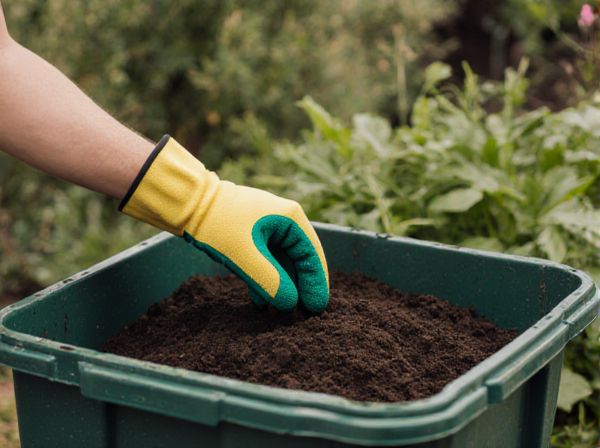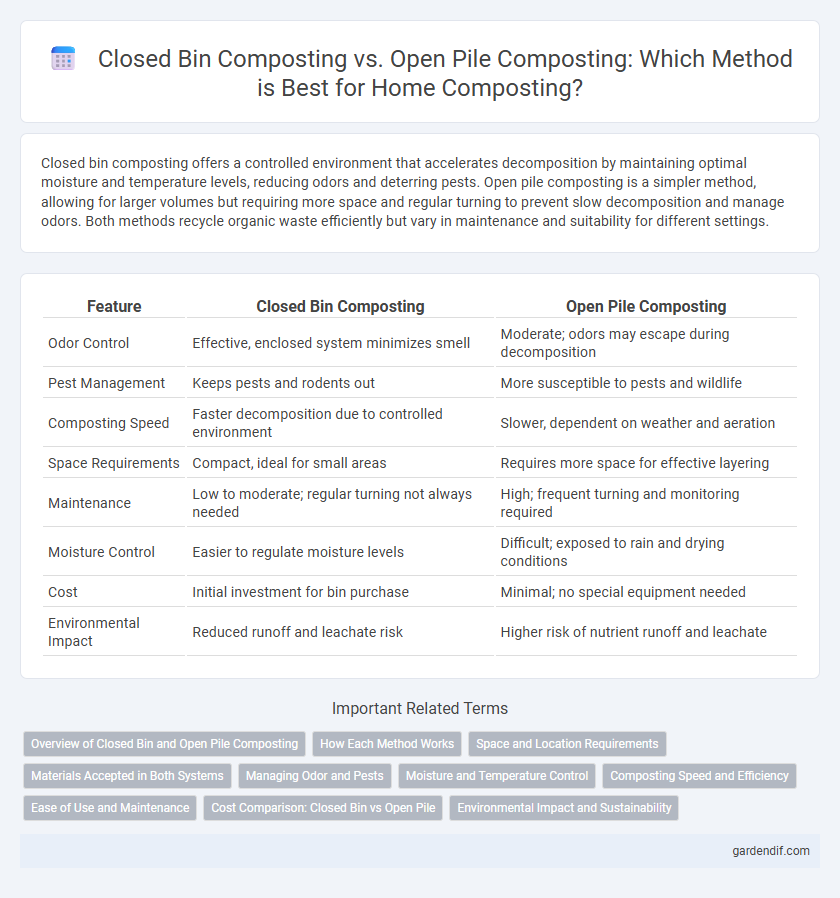
Closed bin composting vs Open pile composting Illustration
Closed bin composting offers a controlled environment that accelerates decomposition by maintaining optimal moisture and temperature levels, reducing odors and deterring pests. Open pile composting is a simpler method, allowing for larger volumes but requiring more space and regular turning to prevent slow decomposition and manage odors. Both methods recycle organic waste efficiently but vary in maintenance and suitability for different settings.
Table of Comparison
| Feature | Closed Bin Composting | Open Pile Composting |
|---|---|---|
| Odor Control | Effective, enclosed system minimizes smell | Moderate; odors may escape during decomposition |
| Pest Management | Keeps pests and rodents out | More susceptible to pests and wildlife |
| Composting Speed | Faster decomposition due to controlled environment | Slower, dependent on weather and aeration |
| Space Requirements | Compact, ideal for small areas | Requires more space for effective layering |
| Maintenance | Low to moderate; regular turning not always needed | High; frequent turning and monitoring required |
| Moisture Control | Easier to regulate moisture levels | Difficult; exposed to rain and drying conditions |
| Cost | Initial investment for bin purchase | Minimal; no special equipment needed |
| Environmental Impact | Reduced runoff and leachate risk | Higher risk of nutrient runoff and leachate |
Overview of Closed Bin and Open Pile Composting
Closed bin composting utilizes enclosed containers to accelerate organic matter decomposition by maintaining controlled temperature, moisture, and aeration, reducing odors and deterring pests. Open pile composting involves stacking organic materials directly on the ground, promoting natural microbial activity but requiring more space and attention to aeration and moisture balance. Both methods effectively recycle organic waste but differ in maintenance, environmental impact, and suitability for urban versus rural settings.
How Each Method Works
Closed bin composting involves placing organic waste into a sealed container that controls moisture, temperature, and aeration to accelerate decomposition while minimizing odors and pests. Open pile composting consists of stacking organic materials in an exposed heap, relying on natural airflow and microbial activity to break down waste, which requires regular turning to maintain oxygen levels and optimize the process. Both methods transform kitchen scraps and yard waste into nutrient-rich compost, but closed bins offer more containment and faster results, whereas open piles are simpler and accommodate larger volumes.
Space and Location Requirements
Closed bin composting requires minimal space and is ideal for small gardens or urban settings due to its compact design, allowing efficient decomposition in confined areas. Open pile composting demands more space and is best suited for larger yards or rural locations where there is ample room for larger, exposed heaps. Location considerations also include factors such as proximity to the kitchen for convenience and adequate airflow to promote aerobic decomposition.
Materials Accepted in Both Systems
Closed bin composting systems accept kitchen scraps like fruit and vegetable peels, coffee grounds, and eggshells as well as yard waste such as grass clippings and small twigs. Open pile composting tolerates a broader range of materials, including larger branches and leaves, cardboard, and paper, although both methods avoid meat, dairy, and oily substances to prevent pests and odors. Both systems rely on a proper balance of green nitrogen-rich and brown carbon-rich materials to optimize decomposition.
Managing Odor and Pests
Closed bin composting effectively manages odor and pests by containing organic materials in an enclosed space that limits exposure to air and animals, reducing smell and deterring flies, rodents, and other pests. Open pile composting tends to produce stronger odors and attract more pests due to its exposure to the environment, requiring regular turning and monitoring to minimize these issues. Incorporating materials with high carbon content and maintaining proper moisture levels are essential in both methods to balance decomposition and control unwanted smells and infestations.
Moisture and Temperature Control
Closed bin composting provides superior moisture and temperature control through its enclosed structure, which retains heat and moisture effectively, promoting faster decomposition and reducing odor. Open pile composting often struggles with inconsistent moisture levels due to exposure to rain and air, leading to fluctuating temperatures that can slow down microbial activity. Maintaining optimal temperature in closed bins, typically between 135-160degF (57-71degC), accelerates the breakdown of organic matter while minimizing nutrient loss.
Composting Speed and Efficiency
Closed bin composting accelerates decomposition by maintaining optimal moisture and temperature levels, resulting in faster organic matter breakdown compared to open pile composting. The enclosed environment minimizes nutrient loss and pest intrusion, enhancing overall efficiency and producing high-quality compost in a shorter timeframe. Open pile composting, while simpler, often experiences slower composting speeds due to fluctuating conditions and greater exposure to environmental elements.
Ease of Use and Maintenance
Closed bin composting offers greater ease of use by containing odors and pests, requiring less frequent turning, and maintaining a more controlled environment, which simplifies maintenance. Open pile composting demands regular manual turning to aerate materials and can attract wildlife, making it more labor-intensive and less manageable for beginners. The contained system of closed bins reduces mess and runoff, enhancing user convenience and consistent compost production.
Cost Comparison: Closed Bin vs Open Pile
Closed bin composting generally incurs higher initial costs due to the purchase or construction of bins and potential aeration systems, yet it minimizes space requirements and odor control expenses over time. Open pile composting demands minimal upfront investment as it often utilizes readily available materials and open areas, but it may involve higher labor costs for turning and managing the pile to prevent pests and odors. Evaluating the total cost, closed bin systems provide long-term savings for urban settings, whereas open pile composting remains cost-effective for rural or spacious environments.
Environmental Impact and Sustainability
Closed bin composting significantly reduces odor and pest issues by containing organic matter, which minimizes greenhouse gas emissions such as methane and carbon dioxide. Open pile composting, while simpler and more cost-effective, often leads to higher nitrogen volatilization and runoff, potentially contaminating nearby soil and water sources. The controlled environment of closed bins enhances decomposition efficiency and nutrient retention, promoting greater sustainability in urban and sensitive ecosystems.
Closed bin composting vs Open pile composting Infographic

 gardendif.com
gardendif.com